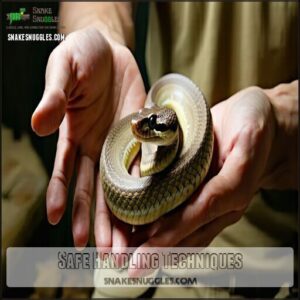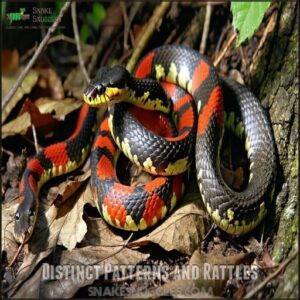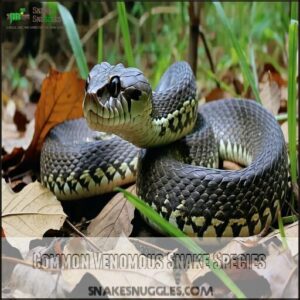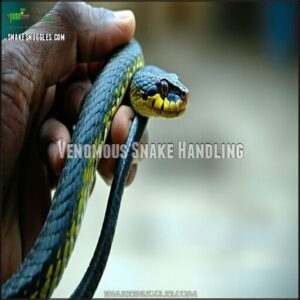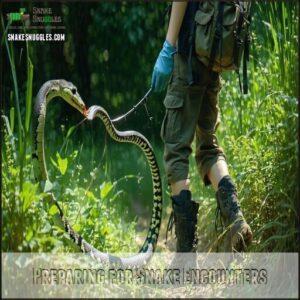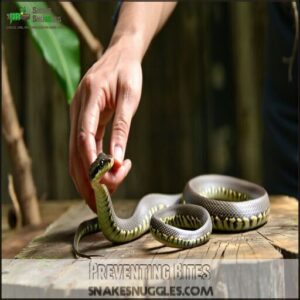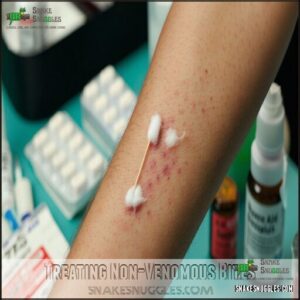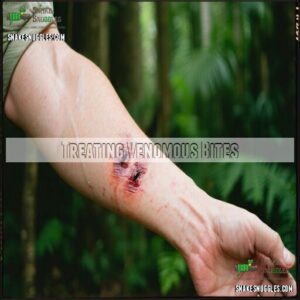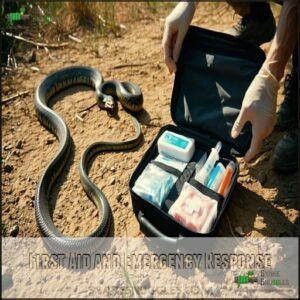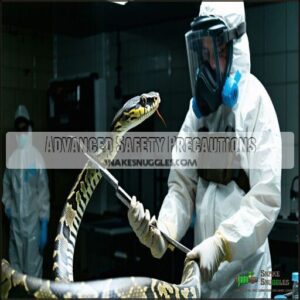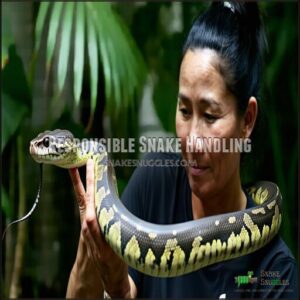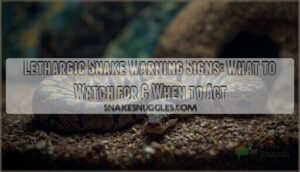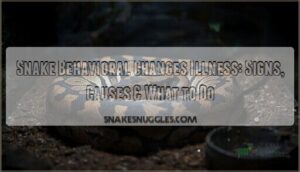This site is supported by our readers. We may earn a commission, at no cost to you, if you purchase through links.
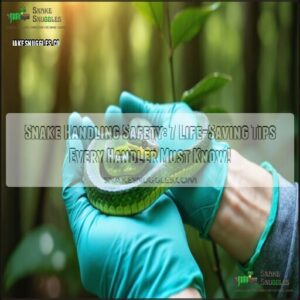
Always move slowly and deliberately, keeping your cool when working with these slithery creatures.
Use specialized tools like snake hooks and wear thick, puncture-resistant gloves to keep yourself protected.
Know your snake’s species and understand its behavior—not all snakes are out to get you, but surprises can be deadly.
Support the snake’s body properly, avoiding sudden movements that might trigger a defensive strike.
Remember, handling snakes isn’t about showing off; it’s about understanding and respecting these fascinating reptiles.
Want to learn how to turn potential danger into a safe, controlled encounter?
Table Of Contents
- Key Takeaways
- Snake Handling Essentials
- Safe Handling Techniques
- Identifying Venomous Snakes
- Venomous Snake Handling
- Preparing for Snake Encounters
- Preventing and Treating Snake Bites
- Advanced Safety Precautions
- Handling Snakes in a Controlled Environment
- Responsible Snake Handling
- Frequently Asked Questions (FAQs)
- How to handle snakes safely?
- What to do if a snake is coming at you?
- What is the risk of handling a snake?
- How to safely pick up a snake?
- What are common myths about handling snakes safely?
- How do weather changes affect snake behavior?
- What should you do after a snakebite incident?
- How can you tell if a snake is injured?
- What makes a good snake handler for beginners?
- How long can snakes live without food?
- Conclusion
Key Takeaways
- You can’t handle snakes safely without specialized protective gear like puncture-resistant gloves, snake hooks, and thick gaiters that shield you from potential strikes.
- Understanding snake behavior is crucial—learn to read their body language, recognize stress signals, and know when to maintain a safe distance to prevent defensive reactions.
- You’ll need to master a calm, deliberate approach when handling snakes, using slow movements, proper body support techniques, and always keeping your cool to minimize risks.
- It’s essential to know the difference between venomous and non-venomous species by identifying key markers like triangular heads, distinctive patterns, and pit organs before attempting any handling.
Snake Handling Essentials
If you’re stepping into snake handling, you’ll need more than just guts and curiosity.
Understanding snake behavior and having the right equipment can mean the difference between a safe encounter and a dangerous mishap.
Recognizing Snake Behavior
When handling snakes, understanding their behavior is your first line of defense.
Snake communication is a silent language of survival, where body signals reveal more than words ever could.
Snake communication is a silent language of body signals that can save your life. Pay attention to these key stress indicators:
- Watch for defensive postures like tail rattling or coiled tension
- Learn to read subtle body language cues
- Recognize aggression triggers before they escalate
Approach every snake with calm, deliberate movements, respecting their personal space and comfort levels.
Common Myths About Snakes
In the wild world of snake encounters, debunking myths is your first line of defense.
Let’s unravel the mystery behind these misunderstood reptiles.
| Myth | Reality |
|---|---|
| Snakes are slimy | Dry, scaled skin |
| They’re vengeful | Purely defensive creatures |
| Always deadly | Most are harmless |
| Seek human contact | Avoid interactions |
| Can hypnotize prey | No snake charming here |
Forget Hollywood’s dramatic portrayals.
Snakes aren’t out to get you—they’re simply trying to survive. Understanding their true nature keeps you safe and respects their role in nature.
Choosing The Right Equipment
Now that you’ve busted those snake myths, let’s gear up for safe handling.
Your protection starts with the right snake safety gear. Here’s what you’ll need:
- Snake-proof gaiters with durable material
- Puncture-resistant gloves with prime grip
- Snake hooks with ergonomic hook design
- Sturdy tongs with precise length control
- Extensive first aid kit with emergency supplies
Professional snake handlers know that quality equipment isn’t just about looking good—it’s about staying safe.
You can find various protective models online.
Your snake handling tools are your first line of defense against unexpected strikes.
Whether you’re a hobbyist or a wildlife professional, investing in first-rate snake handling gloves and specialized equipment can mean the difference between a close call and a dangerous encounter.
Safe Handling Techniques
Regarding handling snakes, you’ll need nerves of steel and a toolbox of smart techniques to stay safe.
Your ability to approach, support, and control a snake can mean the difference between a smooth interaction and a potentially dangerous situation.
Approaching The Snake
When you’re near a snake, your first move matters most.
Maintain a safe distance and watch closely.
Notice its body language—are scales raised? Triangular head? These red flags signal potential danger.
Approach slowly, like you’re tiptoeing past a sleeping cat. Your calm demeanor can make all the difference between a peaceful encounter and a defensive strike.
Picking Up The Snake
When you’re ready to pick up a snake, think of it like handling delicate china.
Your calm approach matters most.
Use a secure grip around the midsection, keeping hands gentle yet firm.
Stay steady and avoid startling movements that might trigger defensive reactions.
With practice, you’ll master these snake handling safety techniques, turning potentially nerve-wracking moments into confident interactions.
Supporting The Snake’s Body
When gripping a snake, think of midsection support like cradling a fragile treasure.
Place your hands underneath its body, spreading weight evenly to prevent injury.
Your snake handling safety depends on gentle coordination—imagine guiding a delicate instrument.
Keep movements smooth and deliberate, letting the snake feel secure in your grasp.
Proper body support isn’t just technique; it’s respect in motion.
Avoiding Sudden Movements
After mastering body support, your next move is smooth, calculated handling.
Sudden jerks can send your scaly friend into defense mode faster than a lightning strike.
Keep your movements slow and predictable, like a gentle breeze.
Think of snake handling as a careful dance: steady hands, calm approach, and gradual exposure.
A snake hook or handling bag can be your secret weapon in maintaining control and minimizing stress during safe snake handling.
Identifying Venomous Snakes
Regarding snake handling, knowing how to spot a venomous snake can mean the difference between safety and serious danger.
You’ll want to learn quick ways to recognize telltale signs like triangular heads, elliptical eyes, distinct patterns, and unique features that scream "back off!" before you get too close.
Triangular Heads and Elliptical Eyes
Sometimes, your snake ID skills could save your life!
Triangular heads and elliptical eyes are nature’s secret code for venomous snake identification.
These distinctive head shape and pupil characteristics serve as critical venom indicators, helping you distinguish potentially dangerous serpents from their harmless look-alikes.
By understanding these evolutionary warning signs, you’ll navigate snake encounters with confidence and caution.
Distinct Patterns and Rattles
Nature’s warning signs can be a snake handler’s best friend. Learn to decode venomous snake identities through their unique exterior signals.
Watch for these critical markers:
- Vibrant, repeating patterns across snake backs
- Intricate camouflage blending with natural environments
- Strategic color combinations like red, yellow, and black
- Confident, defensive body language revealing species characteristics
Pit Organs and Other Identifying Features
Venomous vipers possess mind-blowing pit organs that act like biological infrared cameras.
Nestled between their eyes and nostrils, these heat-sensing pits can detect warm-blooded prey with astonishing precision.
Let’s explore the fascinating world of snake identification! Their triangular head shape is another key identifier.
| Feature | Description |
|---|---|
| Pit Organs | Infrared radiation detectors |
| Location | Between eyes and nostrils |
| Function | Heat signature detection |
| Hunting Advantage | Precise prey tracking |
| Identification Marker | Unique to many venomous species |
Would you dare to look closer?
Common Venomous Snake Species
After exploring pit organs, now it’s time to meet the venomous snake species that roam North America.
Rattlesnakes, with their menacing rattle and diamond patterns, pack a serious punch.
Copperheads blend into their surroundings with copper-red heads and hourglass bands.
Keep your eyes peeled for those tell-tale triangular heads and elliptical eyes – your first line of defense against a potentially dangerous encounter.
Venomous Snake Handling
When handling venomous snakes, you’re stepping into a world where one wrong move could mean life or death.
Your safety depends on mastering precise techniques, utilizing specialized tools, and maintaining unwavering focus during every single interaction.
Positioning Your Hands
When dealing with venomous snakes, your hand placement can mean the difference between safety and danger.
Master the two-handed handling technique with these pro moves:
- Secure a gentle mid-body hold
- Position one hand carefully behind the snake’s head
- Keep a respectful distance from potential strike zones
Stay calm, move slow, and remember: confidence is your best protective gear.
Maintaining Control and Stability
After carefully mastering hand placement, you’ll want to lock down your control and stability game.
Your grip strength becomes your lifeline when handling venomous snakes. Think of it like holding a live wire – steady, firm, but not crushing.
| Risk Level | Handler Response |
|---|---|
| Low Alert | Relaxed grip |
| Moderate | Increased focus |
| High Risk | Maximum control |
| Extreme | Partner assistance |
| Critical | Immediate release |
Body support isn’t just about strength – it’s about smooth, calculated movements.
Even weight distribution prevents sudden shifts that might startle the snake.
Your positioning determines everything: stand balanced, move deliberately, and keep your cool.
Remember, snakes sense your energy, so confidence is key.
Utilizing Snake Hooks or Tongs
Snake hooks and tongs are your lifeline when handling venomous snakes. Master these tools to keep a safe distance and control.
Choose hook material wisely, considering its weight and flexibility. Practice your grip strength and learn how different snake species react.
Your tools are more than equipment—they’re your silent guardians between you and potential danger. Knowing how to identify defensive snake postures can further improve safety.
- Select hooks matching your snake’s size and behavior
- Inspect tong grip before each use
- Practice smooth, controlled movements with your tools
Working With a Partner or Experienced Handler
After mastering snake hooks, you’ll want a trusted partner by your side.
Collaborative handling means double the eyes, halved risks.
An experienced handler brings critical safety protocols, shared equipment, and emergency know-how.
You’ll learn subtle communication cues, spot potential dangers faster, and have immediate backup if things go sideways. Two heads are definitely better than one when wrestling with venomous serpents.
Preparing for Snake Encounters
You’re about to step into the wild world of snake encounters, where preparation can mean the difference between a close call and a catastrophic bite.
With the right gear, a calm mindset, and a few smart strategies, you’ll be ready to handle these slithery situations like a pro.
Wearing Protective Gear
Safety in snake handling begins with armor—protective gear that shields you from potential strikes.
Your defense strategy starts with selecting the right equipment to minimize risks. Here are three critical considerations:
- Material Mastery: Choose snake handling gloves with puncture-resistant leather, snakeproof gaiters made from thick canvas, and boots with reinforced ankle protection.
- Fit and Function: Confirm your protective clothing allows comfortable movement while providing maximum coverage against potential bites.
- Durability Check: Regularly inspect gear for wear, tears, or weakening materials that could compromise your safety.
By investing in high-quality protective clothing, you’ll create a critical barrier between you and potential snake encounters, turning potential danger into manageable interaction.
You may need to acquire specialized handling gloves for added safety.
Sanitizing Your Hands and Equipment
After suiting up in protective gear, your snake handling journey demands spotless hands and equipment.
Bacteria and nasty critters like salmonella can lurk on surfaces, turning your adventure south.
Grab that hand sanitizer and disinfectant wipes to create a shield against potential infections.
Scrub your hands thoroughly with soap, paying attention to nooks and crannies.
For equipment cleaning, use specialized disinfectant types that won’t damage your gear.
A quick wipe-down before and after handling can mean the difference between a safe encounter and an unwelcome health risk. Stay sharp, stay clean.
Creating a Safe Environment
Every square inch of your snake handling space matters when creating a safe environment.
Clear the area of distractions, children, and pets before beginning.
Secure enclosures prevent unexpected escapes, while maintaining a calm mindset reduces risk. Use snake hooks and handling gloves to maintain control and distance.
Inspect your workspace thoroughly, removing potential hazards like loose objects or sharp edges.
Create an emergency plan with contact numbers for reptile experts. Your vigilance is key to snake handling safety—a well-prepared handler minimizes risks and makes certain both human and snake remain protected during interactions. Clear the area of distractions, children, and pets before beginning. Secure enclosures prevent unexpected escapes, while maintaining a calm mindset reduces risk.
Knowing When to Handle Snakes
Timing is everything when handling snakes.
Wait 48-72 hours post-feeding to prevent regurgitation and watch for defensive signals during shedding periods.
Understand your snake’s temperament—some species are more docile than others. Check for stress indicators like hissing or coiled posture before picking them up.
Minimize handling frequency to keep your scaly friend calm and comfortable.
Protective gear can minimize bite risk. Snake handling safety starts with patience and respect.
Preventing and Treating Snake Bites
You’re walking a tightrope between fascination and danger when handling snakes, so understanding bite prevention and treatment isn’t just smart—it’s survival.
Whether you’re a curious beginner or a seasoned handler, knowing how to prevent and respond to snake bites can mean the difference between a close call and a life-threatening emergency.
Preventing Bites
Traversing snake territories demands sharp awareness and strategic preparation. Your safety hinges on smart prevention techniques.
Stay sharp, move slow, and respect the serpent’s domain—your survival depends on it.
Here are five bite-prevention lifesavers:
- Stay alert in wild environments
- Wear snake-proof boots and gaiters
- Use long-handled tools for exploration
- Move slowly and deliberately
- Respect snake habitats and boundaries
Maintaining a safe distance, wearing protective gear, and adopting a calm approach will dramatically reduce your snake bite risk.
Treating Non-Venomous Bites
When a non-venomous snake decides to bite, stay calm.
Carefully wash the wound with soap and water, then disinfect thoroughly. Apply an antiseptic and cover with a clean bandage to prevent infection. Over-the-counter pain relievers can help manage discomfort.
Monitor the bite site closely for any signs of swelling or redness. If complications arise, don’t hesitate to contact a healthcare professional.
Treating Venomous Bites
When facing a venomous snake bite, quick and calm action is paramount.
Recognize critical bite symptoms like swelling and pain, then seek immediate medical assistance.
Antivenom administration within six hours can be a lifesaver, especially during the first golden hour.
Remember, professional medical intervention trumps home remedies—your health depends on expert snake bite first aid.
First Aid and Emergency Response
When a snake strikes, your swift response can turn the tide.
Remember these lifesaving tips:
- Remain calm and assess bite symptoms quickly
- Immobilize the affected area to slow venom spread
- Contact emergency services immediately
- Prepare critical medical information for responders
Don’t fall for myths—no cutting or sucking wounds! Antivenom access and proper first aid are your best defense against venomous snake bite complications.
Stay alert, act smart.
Advanced Safety Precautions
When handling snakes, you’re stepping into a world where one wrong move can turn deadly serious, so it’s critical to understand the advanced safety precautions that could save your life.
By mastering specialized equipment, maintaining a safe distance, and knowing exactly when to call in the professionals, you’ll dramatically reduce your risk of a dangerous encounter with these fascinating but potentially lethal reptiles.
Understanding The Potential Consequences
When preventing snakebites isn’t enough, understanding potential consequences becomes your safety lifeline.
Bite severity can range from minor punctures to life-threatening envenomation.
Your quick awareness could mean the difference between minor treatment and serious medical intervention.
| Risk Level | Physical Impact | Psychological Effect |
|---|---|---|
| Mild | Minor wounds | Temporary anxiety |
| Moderate | Localized pain | Heightened fear |
| Severe | Systemic shock | Long-term trauma |
| Critical | Organ damage | Persistent stress |
| Extreme | Life-threat | Deep-rooted phobia |
Knowing When to Seek Professional Assistance
When you’re staring down an unidentified snake showing unusual behavior, it’s time to call in the pros.
Professional handlers can manage envenomation risks and loss of control scenarios better than you.
Watch for tricky signs like strange movements or aggressive postures.
Emergency response teams with antivenom expertise are your safest bet when handling difficulty spikes.
Utilizing Specialized Equipment
Stepping beyond professional guidance, your snake handling safety hinges on smart equipment choices.
Arm yourself with precision tools that keep you protected. Snake hooks and tongs become your silent guardians, offering control without confrontation. Your gear isn’t just equipment—it’s your lifeline. Many handlers find that specialized hook designs improve safety.
- Master species-specific snake handling tools
- Invest in high-quality protective gear
- Learn proper hook and tong techniques
- Understand equipment maintenance basics
- Choose restraint tools wisely
Maintaining a Safe Distance
Keep your wits sharp and your distance wider than a snake’s strike zone!
Never corner or trap a snake, as this triggers defensive behaviors.
Utilize safe tools like hooks and tongs to maintain proper reach distance.
Position yourself carefully, always leaving an escape route.
Remember, handler positioning isn’t just about technique—it’s about respecting the snake’s space and preventing potential confrontations.
Handling Snakes in a Controlled Environment
Mastering snake handling begins with creating a fortress of safety—a controlled environment where precision meets respect.
Your reptilian companion deserves a carefully planned space that minimizes risks and maximizes understanding.
Here’s how to transform any area into a snake sanctuary:
- Enclosure Security: Design a space that’s escape-proof, with smooth walls and secure latches.
- Temperature Control: Maintain prime climate conditions using precise heating and cooling methods.
- Quarantine Protocols: Implement strict isolation procedures for new or unfamiliar snakes.
Temperature, humidity, and cage furnishings aren’t just details—they’re lifelines.
Remember that proper enclosure design is vital for a safe environment.
Whether you’re working with a docile corn snake or a more challenging species, your controlled environment becomes your first line of defense.
Think of it as creating a micro-ecosystem that whispers, "Safety first, adventure second.
Responsible Snake Handling
Regarding snake handling, you’re not just dealing with a pet—you’re interacting with a potentially dangerous wild animal that demands your utmost respect and attention.
Your safety and the snake’s well-being depend on understanding its behavior, mastering proper techniques, and approaching each interaction with knowledge, care, and calm precision.
Education and Training
Snake handling isn’t for the faint of heart—it’s a skill that demands serious education and training.
Your journey starts with professional certification programs and species-specific workshops that teach you the ropes.
Check out these training opportunities:
| Training Type | Focus Area |
|---|---|
| Certification | Safety Protocols |
| Workshops | Venomous Snake ID |
| Mentorship | Hands-on Experience |
Expert guidance transforms novices into confident handlers. By investing in quality education, you’ll learn to read snake body language, understand behavior patterns, and minimize risks.
Remember, knowledge isn’t just power—it’s your shield against potential snake-handling mishaps. Stay curious, stay safe.
Importance of Proper Handling Techniques
Anyone can learn safe snake handling techniques, but mastering them requires practice and patience.
Proper handling is an art form that protects both you and the snake.
Imagine approaching this delicate dance with confidence:
- Gentle body support prevents stress
- Smooth, predictable movements build trust
- Careful positioning minimizes risk
- Controlled approach reduces snake anxiety
- Respectful interaction guarantees safety
Your calm demeanor becomes your most powerful tool.
Understanding The Behavior of Venomous Snakes
When venturing into snake territory, stay sharp and learn to read their defensive signals. Understanding venomous snake behavior transforms fear into respect. Here’s what you’ll want to know:
- Watch for S-shaped coiling and rapid tongue flicks, classic stress indicators.
- Recognize pit organs and elliptical eyes as key venomous snake identification markers.
- Remember that cornered snakes display the most aggressive body language.
These insights help you distinguish between a warning and a potential threat, turning an encounter from potentially dangerous to a fascinating wildlife moment.
Promoting Safe and Responsible Snake Handling
Your snake handling journey is a blend of science, respect, and skill.
Learn ethical snakekeeping through public education and conservation concerns.
Understand that responsible handling isn’t just about technique—it’s about protecting both human and reptile lives. Practice safe snake handling techniques with patience, knowledge, and a deep appreciation for these incredible creatures’ roles in our ecosystem.
Frequently Asked Questions (FAQs)
How to handle snakes safely?
Skillfully slithering into safety, you’ll want protective gloves, a calm demeanor, and a snake hook.
Move slowly, support the snake’s body gently, and always respect its space to prevent startling or defensive strikes.
What to do if a snake is coming at you?
Stay calm and still.
Don’t run or make sudden moves.
Slowly back away while keeping your eyes on the snake.
Maintain a safe distance and create an escape route for both you and the snake.
What is the risk of handling a snake?
Death might be your dance partner when handling snakes!
You’ll face serious risks like venomous bites, bacterial infections, and potential life-threatening injuries if you’re not careful, trained, and equipped with proper safety gear.
How to safely pick up a snake?
Always use a snake hook to gently guide the snake before carefully supporting its mid-body with both hands.
Move slowly, avoid sudden movements, and never grab near the head to prevent defensive strikes.
What are common myths about handling snakes safely?
Picture a snake handler‘s wild tales – many myths lurk in the shadows.
You’ll dodge dangerous misconceptions by trusting expert advice, understanding snake behavior, and never believing Hollywood’s dramatic snake-handling fantasies.
How do weather changes affect snake behavior?
When temperatures drop, snakes slow down and seek warmth, becoming less active.
Conversely, hot weather drives them to cool, shaded areas.
Their metabolism and movement directly correlate with environmental temperature changes.
What should you do after a snakebite incident?
Stay calm and remain still.
Call emergency services immediately.
Remove tight clothing or jewelry near the bite. Keep the bite area below heart level.
Don’t attempt to suck out venom or apply a tourniquet.
Seek professional medical help quickly.
How can you tell if a snake is injured?
You’ll spot snake injuries by checking for unusual movements, lethargy, visible wounds, abnormal skin color, and changes in breathing.
Look for signs like difficulty slithering, swelling, or bleeding that indicate the snake needs professional veterinary care.
You can identify the need for care by observing unusual movements and other signs.
What makes a good snake handler for beginners?
When Jake first held a corn snake, he learned patience and calm were key.
A good beginner handler respects the snake’s space, moves slowly, wears protective gear, and educates themselves about snake behavior before handling.
How long can snakes live without food?
You’ll be surprised how long some snakes can go without a meal.
Depending on their species and metabolism, they can survive weeks to months without food, with larger snakes handling longer fasting periods more comfortably.
Conclusion
Remember when your grandpa warned you about dangerous wildlife?
Snake handling safety isn’t just a skill—it’s a lifeline. You’ve learned critical techniques that transform potential risks into controlled encounters.
By mastering proper approaches, understanding snake behavior, and respecting these fascinating creatures, you’ll protect yourself and the snakes.
Whether you’re a wildlife professional or curious enthusiast, knowledge is your greatest defense.
Stay alert, stay informed, and handle with care.


